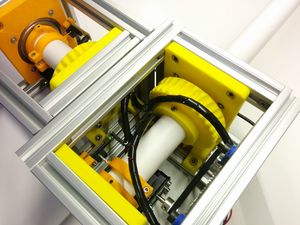SatNOGS Rotator v3
| SatNOGS Rotator v3 | |
|---|---|
| Rotator Information | |
| Type: | Az/El |
| Cost: | {{{cost}}} |
| Release Information | |
| Status: | Beta |
| Latest Release: | Torx Flathead (v3.0) |
| Repository: | [1] |
| Documentation: | [2] |
Intro
v3 marks a major re-haul of the SatNOGS Rotator design, with learnings from v2 applied. You can see a lot of the thinking and background research that was conducted prior to v3 development in this thread.
Specifications
| ' | SatNOGS v3 Rotator |
| Plastic Parts | 26 |
| Non Printed Parts approx. | 345 |
| Cost | ~ $220 |
| Controller Electronics | SatNOGS Rotator Controller |
| Type | Az/El (possible X/Y) |
| Motors | 2x NEMA 17 Stepper or 2x DC Motors |
| Frame Material | Aluminum T-slot 20x20 |
| Pro | |
| Con | |
Sourcing
3d Printing at a Fab Lab- If you don't have your own 3d printer then a local Fab Lab may be able to do it for you. Fab Labs are places that have invested in the machinery and you can take the designs to them. Generally they need .stl files to import into the software that runs the machines but this should be discussed with the Fab Lab. You then pay for the colume of material or tme or a combination of the two for each of the parts [3]
T Slot - If you don't want to cut the pieces yourself then here is a UK supplier[4] Hidden corner connectors - AliExpress gave the cheapest supplier
Stepper Motors - eBay
Belts - eBay
Fixings / Pipe - eBay
Antenna Hardware - The yagi antenna is suited to the novice builder but there are many types. Each satellite has an uplink and a downlink so it is necessary to have an antenna that will work on the downlink side for receiving and one for the uplink if you are transmitting to the satellite (Transmitting requires a licence - an amateur radio licence normally suffices fr most countries). Antennas have a gain associated with them that is related to the number of elements. Simply the greater the number of elements the greate the gain, however the more directional they become and the greater accuracy is needed. So a trade off between gain and beam width is required. Nominally a 3 element beam for 145Mhz (2m band) and a 7 element beam for 432MHz (70cms band) will suffice for most applications. Some satellites need a different type of antenna that has circular polarisation and these are helical to look at. The satNOGS helical design should be followed. A simple to build antenna can be sources from Nuxcomm [5]
Receiver - The RTL-SDR dongle used for the reciver is a broad band software defined receiver (SDR) that uses a common IC for the receiver and simple filtering. Its intended use is for TV, FM and DVB reception. It can be hacked, using the right drivers to be a very capable and cheap receiver. Fot further information see here[6]. eBay will be able to offer you good value.
Build Tips
T slot and corner fixings - Alignment of worm gear and spur gear - PCB's -
Test Sequence
Test sequence needed
